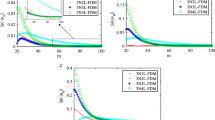Abstract
A new method for calculation of chip removal machining stability diagrams is proposed. The method can be considered as an application of the Floquet theorem by repeated time integrations and represents an alternative to the previously presented time domain stability methods (semi-discretisation, time finite elements and so on), without the requirement to build the transition matrix. In this way, the computation effort is very much reduced, especially when the required number of segments is large. As a result, the computing time depends on the number of segments with an exponent 1.5, instead of 2.8 that is the exponent for the optimised semi-discretisation. This results in that the presented method is the most efficient among the previous ones. As a further advantage, the memory requirements for the method are much lower, allowing computing very-high-order stability lobes. As a drawback, for the computation of high-order lobes, the method is not as efficient as could be expected, due to the slow convergence of the eigensystem resolution when many eigenvalues of similar magnitude exist. Even in that case, the method is five times faster than the optimised semi-discretisation, but a more efficient eigenvalue resolution method is sought for.
Similar content being viewed by others
References
Tobias SA, Fiswick W (1958) Theory of regenerative machine tool chatter. Engineer 205:199–203
Tlusty J, Polacek M (1957) Beispiele der behandlung der selbsterregten schwingung der werkzeugmaschinen. FoKoMa, Hanser Verlag, Munich
Merritt HE (1965) Theory of self-excited machine tool chatter. J Eng Ind-T ASME 87:447–454
Opitz H (1969) Investigation and calculation of the chatter behavior of lathes and milling machines. CIRP Ann 18:335–342
Minis I, Yanushevsky T, Tembo R, Hocken R (1990) Analysis of linear and nonlinear chatter in milling. CIRP Ann 39:459–462
Floquet MG (1883) Équations différentielles linéaires à coefficients périodiques. Ann Sci de l’École Normale Supérieure 8:1–36
Budak E, Altintas Y (1998) Analytical prediction of chatter stability conditions for multidegree of freedom systems in milling. Part I: general formulation, Part II: application of the general formulation to common milling systems. J Eng Ind-T ASME 120:22–36
Altintas Y, Budak E (1998) Analytical prediction of stability lobes in milling. CIRP Ann 44:357–362
Davies MA, Pratt JR, Dutterer BS, Burns TJ (2000) The stability of low radial immersion milling. CIRP Ann - Manuf Tech 49(1):37–40
Insperger T, Stépán G (2002) Semi-discretization method for delayed systems. Int J Numer Methods Eng 55:503–518
Insperger T, Mann BP, Stépán G, Bayly PV (2003) Stability of up-milling and down-milling, part 1: alternative analytical methods. Int J Mach Tools Manuf 43:25–34
Bayly PV, Halley JE, Mann BP, Davies MA (2003) Stability of interrupted cutting by temporal finite element analysis. J Manuf Sci Eng 125:220–225
Insperger T, Stépán G, Turi J (2008) On the higher-order semi-discretizations for periodic delayed systems. J Sound Vib 313:334–341
Butcher E, Ma H, Bueler E, Averina V, Szabo Z (2004) Stability of linear time-periodic delay-differential equations via Chebyshev polynomials. Int J Numer Methods Eng 59:895–922
Compeán FI, Olvera D, Campa FJ, López de Lacalle LN, Elías-Zúñiga A, Rodríguez CA (2012) Characterization and stability analysis of a multivariable milling tool by the enhanced multistage homotopy perturbation method. Int J Mach Tools Manuf 57:27–33
Merdol SD, Altintas Y (2004) Multi frequency solution of chatter stability for low immersion milling. J Manuf Sci Eng 126(3):459–466
Zatarain M, Bediaga I, Muñoa J, Insperger T (2010) Analysis of directional factors in milling: importance of multi-frequency calculation and of the inclusion of the effect of the helix angle. Int J Adv Manuf Technol 47(5):535–542
Dombovari Z, Altintas Y, Stepan G (2010) The effect of serration on mechanics and stability of milling cutters. Int J Mach Tools Manuf 50(6):511–520
Arnaud L, Gonzalo O, Seguy S, Jauregi H, Peigné G (2011) Simulation of low rigidity part machining applied to thin-walled structures. Int J Adv Manuf Technol 54(5–8):479–488
Szalai R, Roose D (2007) Continuation and bifurcation analysis of delay differential equations. Numerical continuation methods for dynamical systems Springer, Netherlands, p 359–399
Adetoro OB, Sim WM, Wen PH (2012) Stability lobes prediction for corner radius end mill using nonlinear cutting force coefficients. Mach Sci Technol 16(1):111–130
Muñoa J, Zatarain Z, Bediaga I, Peigné G, Stability study of the milling process using an exponential force model in frequency domain CIRP—2nd International HPC Conference, Vancouver
Dombovari Z, Wilson RE, Stepan G (2008) Estimates of the bistable region in metal cutting. Proc Royal Soc A 464(2100):3255–3271
Dombovari Z, Barton DAW, Wilson RE, Stepan G (2011) On the global dynamics of chatter in the orthogonal cutting model. Int J Non-Linear Mech 46(1):330–338
Bachrathy D, Stepan G (2013) Improved prediction of stability lobes with extended multi frequency solution. CIRP Ann-Manuf Technol 62(1):411–414
Zatarain M, Munoa J, Peigné G, Insperger T (2006) Analysis of the influence of mill helix angle on chatter stability. CIRP Ann - Manuf Tech 55(1):365–368
Szekrenyes A (2015) A special case of parametrically excited systems: free vibration of delaminated composite beams. Eur J Mech A/Solids 49:82–105
Hale J (1977) Theory of functional differential equations. Springer-Verlag, New York
Farkas M (1994) Periodic motions. Springer-Verlag, Berlin and New York
Bachrathy D, Stépán G (2012) Bisection method in higher dimensions and the efficiency number. Periodica Polytechnica - Mech Eng 56(2):81–86
Henninger C, Eberhard P (2008) Improving the computational efficiency and accuracy of the semi-discretization method for periodic delay-differential equations. Eur J Mech A Solids 27(6):975–985
Dombovari Z, Iglesias A, Zatarain M, Insperger T (2011) Prediction of multiple dominant chatter frequencies in milling processes. Int J Mach Tools Manuf 51(6):457–464
Altintas Y, Stepan G, Merdol D, Dombovari Z (2008) Chatter stability of milling in frequency and discrete time domain. CIRP J Manuf Sci Technol 1:35–44
Author information
Authors and Affiliations
Corresponding author
Rights and permissions
About this article
Cite this article
Zatarain, M., Alvarez, J., Bediaga, I. et al. Implicit subspace iteration as an efficient method to compute milling stability lobe diagrams. Int J Adv Manuf Technol 77, 597–607 (2015). https://doi.org/10.1007/s00170-014-6470-7
Received:
Accepted:
Published:
Issue Date:
DOI: https://doi.org/10.1007/s00170-014-6470-7




